Here in Iceland, we are quite lucky to live on an incredibly beautiful and naturally diverse rock in the middle of the Atlantic. Though small in size, Iceland has perhaps the most mesmerising breadth of nature which includes: volcanoes, glaciers, lava fields, mountains, fjords, ravines, hot springs and the most incredible waterfalls.
Here, we asked a Reykjavík-based writer Chris Ayliffe to cover the top 10 waterfalls in Iceland, from their structural grace and beauty to the folklore and geological prowess they bring to the country. Forming this list took time and a considerable amount of debate from the team due to the sheer number of spectacular falls in Iceland. But, we’re pretty confident we’ve nailed down the best 10. To find out why Iceland has so many waterfalls, read more here.
Read on to discover Chris' take on Iceland's best falls and how you can find them, as well as those you’ll get to see from a series of unbelievable perspectives on Flyover Iceland’s ultimate flying ride.
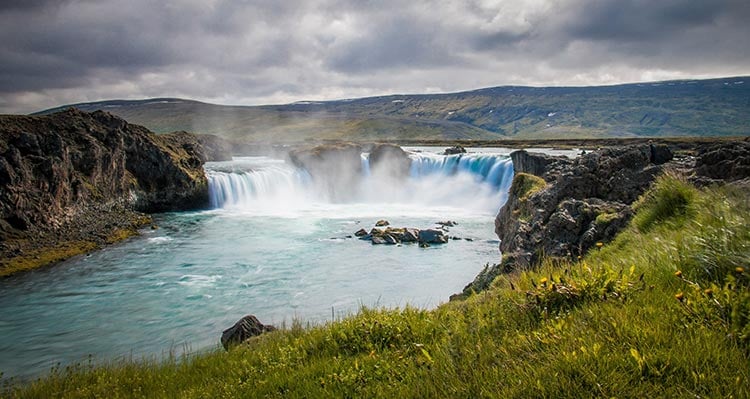
North Iceland is perhaps one of the most under-looked areas of the country, and yet it hosts a series of the most awe-inspiring waterfalls and natural attractions.
First up is the powerful and stunning waterfall of Goðafoss. This thunderous titan is 12 metres high and just over 30 metres in width. Sitting on the Skjálfandafljót river, Goðafoss can easily be reached on around a 30-minute drive from the city of Akureyri just off of the famous ring road (route 1), making up part of the Diamond Circle route.
This waterfall has also been steeped in Icelandic folklore for generations. Legend has it that in 1000 AD, the famous lawmaker Þorgeir Ljósvetningagoð returned to the north of Iceland from the Alþingi (Icelandic Parliament) in Þingvellir having made Christianity the official religion of Iceland. As an act of goodwill, Þorgeir then allegedly cast his statues of the pagan Norse Gods into the waterfall, earning it the name of Goðafoss, or ‘Waterfall of the Gods’ in English.
Though somewhat contrastingly, more recently linguist and place name expert Savar Sigmundsson has actually suggested the name has a different origin. He suggests that the name actually derives from two crags you can find at the falls which resemble pagan idols.
You’ll have to check out Goðafoss for yourself to come to a conclusion as to whether folklore or interpretation of the local people is the true origin of the name. The truth is probably somewhere in the middle, but knowing the full truth would be no fun at all!
For those of you more keen to photograph this natural wonder you have two options. You can either capture the full waterfall framed by the mountains behind from the western shore, or get much closer to the falls on the eastern shore. Both offer fantastic photography opportunities, so I personally suggest trying both if you have the time.
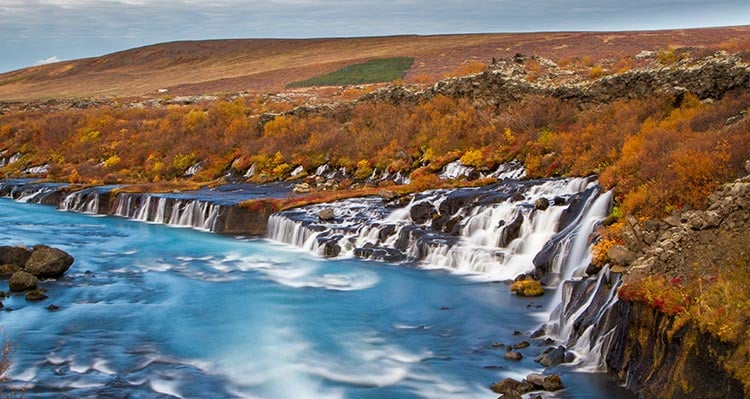
In contrast to many waterfalls in my top ten, Hraunfossar stands out as a little bit more unique.
Translating to ‘Lava Falls’, this peaceful trickling waterfall spans a width of 900 metres formed by a series of rivulets out of the Hallmundarhraun lava field. Hallmundarhraun itself, actually formed after an ancient eruption from a nearby subglacial volcano that sits beneath the local glacier of Langjökull.
This waterfall is particularly impressive to look at due to the variety of colours which form as a result of the old mineral-rich lava flows reacting with the pouring glacial meltwaters. If you’re visiting in summer and spring you’ll see a stunning array of oranges and blues. Whereas, in winter the contrast of the ice and snow to the dark rocks and fairytale blue waters makes this a completely different surreal location.
Hraunfossar also comes with a bonus. Just upstream along the Hvítá river is the much more powerful waterfall of Barnafoss. Contrastingly, this neighbouring waterfall, known as ‘Children’s Waterfall’ due to the folklore of two children lost during a church service, is incredibly thunderous and loud as it roars violently into the caverns beneath.
Though not sitting in first position, I can confidently say that this location definitely comes up as the best two for one waterfall experience you can get in Iceland.
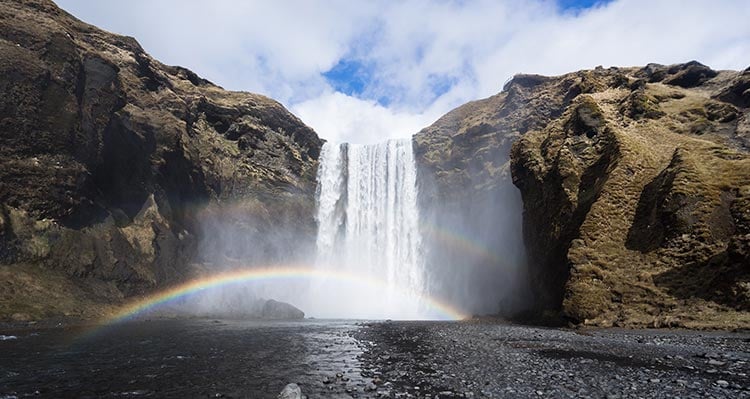
There are so many waterfalls decorating the south coast of Iceland that it is impossible to not go chasing waterfalls—much to the concern of TLC I’m sure.
In Iceland, where there’s glaciers you can be certain there are going to be an array of stunning waterfalls. The south coast of Iceland just so happens to be the ultimate glacier destination with the prominent Eyjafjallajökull, Mýrdalsjökull and Europe’s largest glacier, Vatnajökull as well as a series of mighty glacier outlets of these titans along the journey.
One of the most visited and impressive of these is the unmissable Skogafoss. Towering up at an impressive height of 60m, this blasting waterfall’s mist can be felt at a great distance from the falls themselves.
You can even take the opportunity to get a different perspective by climbing the steps to a viewing platform at the top of the falls which also leads to the base of one of Iceland’s famous hiking trails.
According to legend, the Viking settler who first founded the town of Skogar, Þrasi Þórólfsson, buried a handsome treasure in the cave located behind the waterfall. Allegedly some locals found the chest years later, but were only able to grab the ring of the side of the chest before it completely disappeared again.
I’ll level with you, though you can walk extremely close to this waterfall, it is certainly not safe to find out if this legend is true for yourself. This is where we all need to listen to the advice of TLC!
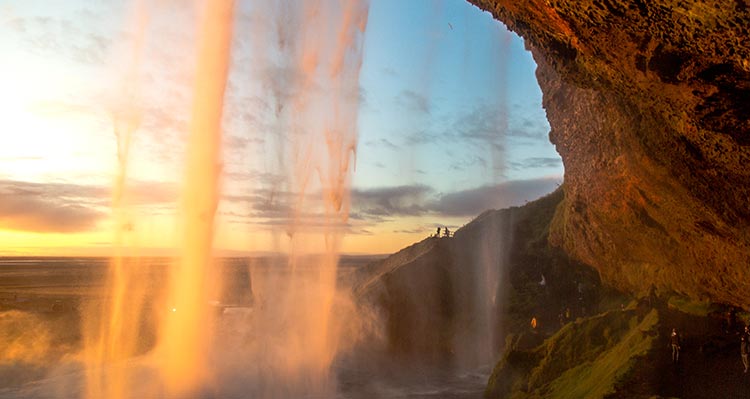
Around a 20-minute drive west of Skogafoss is one of Iceland’s most recognisable waterfalls, Seljalandsfoss.
Sitting at the same height of Skogafoss at 60 metres, these waterfalls couldn’t be more different. Where Skogafoss is incredibly thunderous and powerful, Seljalandsfoss is much thinner and quieter nestled on the ridge of a picturesque canyon.
What makes Seljalandsfoss unique is it’s perfectly shaped cavern behind its falls. This allows visitors to fully circumnavigate the waterfall in all months except the winter months where the walk can become too treacherous due to ice and snow. This helps to make it a particular wonder for photographers.
If you’re planning a visit in summer, you can easily head behind the falls with your tripod and DSLR camera in the aim of capturing the glistening falls in the golden hours of the midnight sun. If you make sure to bring a ND filter, you will be able to create some fantastic long exposure snaps. This is a feat that should be on a photographer's bucket list for sure!
While you’re stopped here, make sure you take extra time to follow the pathway to the end of the promenade west where you’ll find the hidden waterfall of Gljúfrabúi. For those of you brave enough to test your balance on a series of slippery stones through a small passageway, you’ll be rewarded with a view of one of Iceland’s beautiful hidden waterfalls. Keep a rain jacket on if you’re sparing a moment to include this adventure, as the passage is narrow and the cavern is extremely wet.
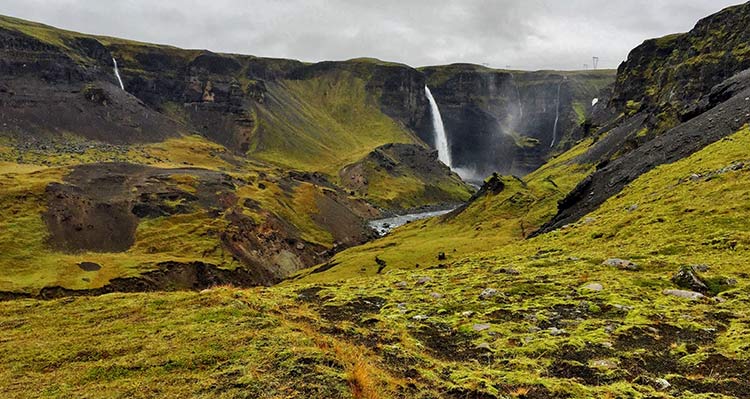
Ok, so I’m cheating here a little bit. Sigöldugljúfur canyon is actually home to a great number of spectacular waterfalls which helped earn its nickname to travellers as ‘the valley of tears’.
Sitting in the Icelandic highlands, Sigöldugljúfur canyon has an exceptional blue river flowing through the colourful vegetation that crowns the rocky walls.
As this canyon sits a little off the beaten path, it’s considered one of Iceland’s hidden gems. To reach there you will need to brave one of the country’s F-roads which requires a four-wheel-drive vehicle or you can join a guided tour.
For those of you keen to make the trek to the better-known region of Landmannalaugar, you can include Sigöldugljúfur canyon along the Sigalda trail. It’s the complete landscape photographers dream with an array of untouched rugged nature to get up close to and explore.
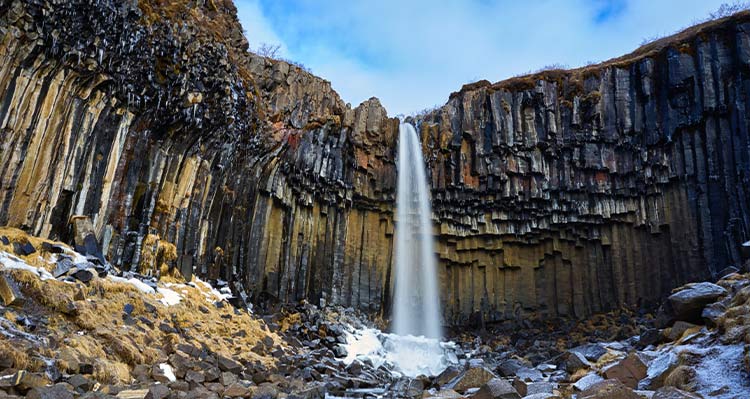
Otherwise known as ‘Black Falls’, this unique spectacle is situated in Skaftafell National Park, and is one of the most popular sights in the area.
Surrounded by a series of dark basalt hexagonal lava columns, this waterfall is a feat of design crafted by nature which has inspired numerous architects. Most notably, this includes the crown jewel of Reykjavík, Hallgrímskirkja church.
The water that carves the 20 metres falls comes from Svinafellsjökull, one of the main glacier outlets of the mighty Vatnajökull glacier.
Svartifoss also has the quirky feature of creating incredibly sharp rocks at the base of its falls. This is due to the hexagonal columns which break much faster than the falling water can wear down the edges. You’ll notice a graveyard of these sharp rocks as you walk close to the waterfall along the river's edge.
To reach Svartifoss, simply park up at the Skaftafell Nature Reserve visitor centre where you’ll take a 45-minute relatively easy hike (1.5km). Along the way you’ll also encounter three other waterfalls: Þjofafoss (Thieves’ Fall), Hundafoss (Dogs’ Fall) and Magnusarfoss (the Falls of Magnus).
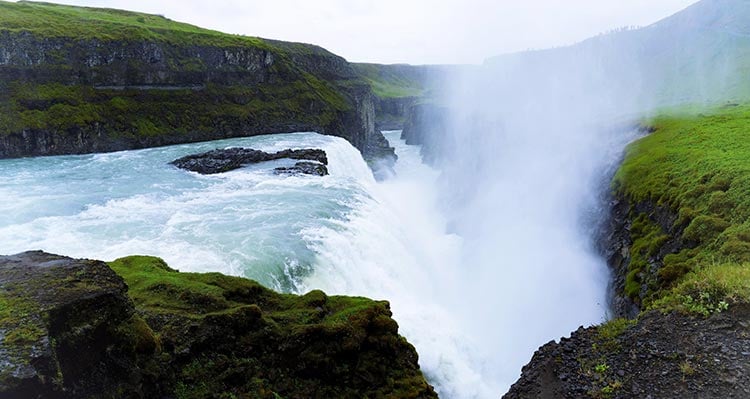
Perhaps the best sight on the most popular travellers trail in Iceland, the Golden Circle, is that of the mighty Gullfoss.
Translating to ‘Golden Falls’, this huge feat of nature cascades down 32 metres over two steps into a large crevice 20 metres in width. The waters are fed by meltwater from the famous Langjökull glacier along the fast-flowing Hvítá river.
Due to its accessibility and relatively close proximity to Reykjavík, Gullfoss has more recently become a great location for photographers to visit in wintertime as one of the best places to see the Northern Lights. A long exposure photo of the mighty waterfall combined with the dancing Aurora Borealis is certainly one you’ll be proud to hang on the fridge when you get home.
Like many other locations in Iceland, Gullfoss has a charming story in folklore to tell. The story goes that there was once a young man who was overseeing his father’s livestock on the river’s west bank. Whilst on the opposite side, a young woman was doing the same for her father.
Over time both the young man and woman started communicating across the river over the thunderous noise of the flowing waters. As is ever the case when people meet by a waterfall, they fell in love with each other which eventually led to the young man proposing marriage.
The young woman humbly accepted his proposal but with one condition: he must cross the river and join her on the east bank. Unlike most men of the modern age who would probably not swipe right based on the risk involved with this young lady, the young man bravely walked across and the couple lived happily ever after.
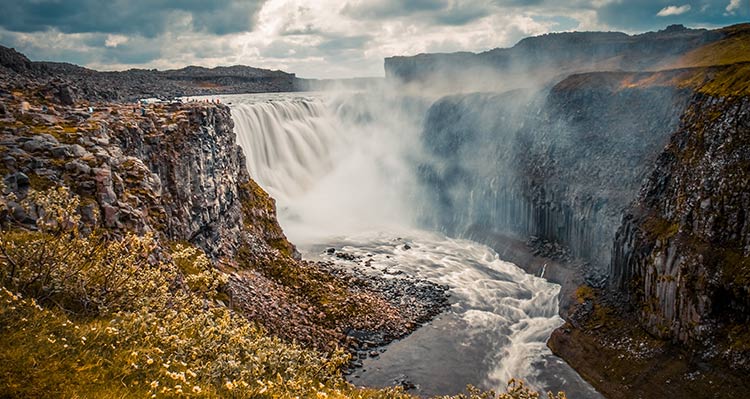
Dettifoss is Europe’s most powerful waterfall as well as Iceland’s largest.
The giant falls plummet down 44 metres across a canyon 100 metres wide, with an average water flow of 193 m³/s. In translation, it’s a ridiculously huge and powerful beast of a waterfall.
As Gullfoss is the crown jewel of the Golden Circle trail, Dettifoss is the prize attraction of the north’s Diamond Circle. In my view, it’s like Gullfoss on steroids and is a contender on this list not to be missed.
Sitting on the Jökulsá á Fjöllum river, whose waters are fueled by Vatnajökull glacier, Dettifoss has two smaller close neighbouring waterfalls also worth a look. Selfoss resides a little upstream (15-minute walk) where Hafragilsfoss is further downstream (40-minute walk or 10-minute drive away).
For the film buffs among you, you should recognise Dettifoss from the Ridley Scott sci-fi classic, Prometheus. It’s the setting of the opening scene, where the creature drinks from a cup and falls into the falls—not a scene to copy or even pretend to!
Similarly to most other waterfalls, when you visit Iceland in winter Dettifoss appears even more stunning due to the powerful contrast from the snow and ice to the darkening falls below. The seasons transform the landscapes from delightful spectrums of colour to snowy winter wonderlands giving you a completely different opportunity to visit.
When it comes to viewing Dettifoss, you have two options. You can either take route 862 to reach the western bank of the river and complete a short walk to a viewing platform. This will provide both an excellent vantage point to watch this ominous waterfall as well as to feel its eerie mist. Or, you can take route 864 to the eastern bank where you can get much closer to the waterfall.
However, be careful when doing so, as the misty sprays regularly make the surrounding area close to the waterfall very slippery and accidents have happened in the past.
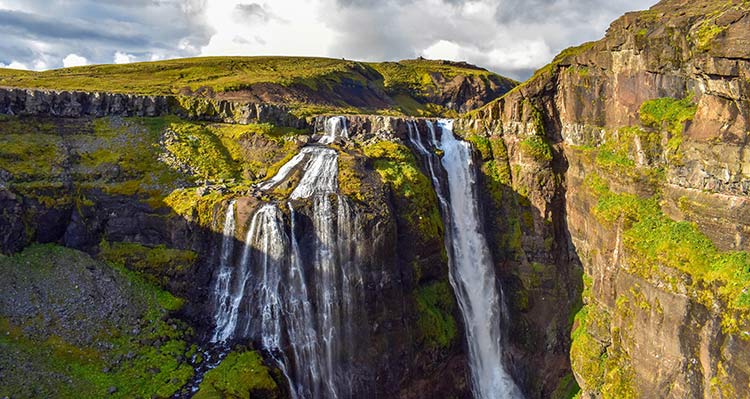
Taking the silver medal on my list is the second tallest waterfall in Iceland, Glymur.
Cascading into a spectacular crafted canyon from a height of 198 metres makes it a truly incredible sight to witness.
What makes Glymur that extra special is the journey to reach it. Sitting at the end of the fjord of Hvalfjörður, you need to take a 3.5 hour hike from the car park which involves wading across a river, passing through a cave and walking along a series of narrow mountainside paths.
It’s not for the faint of heart, but for those of you ready to brave the hike will reap your reward when you’re finally witnessing this giant waterfall which continues to carve the canyon below.
The waterfall itself is fed by the river Botnsá which you can even wade in from the top of the falls. Be careful though, especially if you’re not at peak fitness. Remember to always go at your own pace and don’t take any unnecessary risks. Iceland is meant to be enjoyed, not feared.
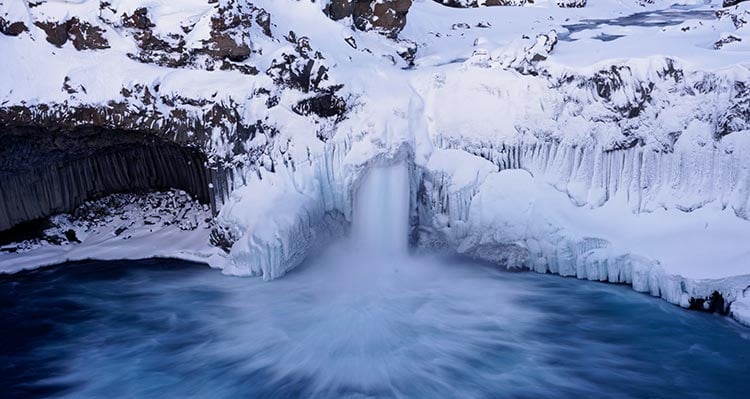
Taking the gold medal on this list goes to another Icelandic highlands belter named Aldeyjarfoss.
With a powerful falls at a height of 20 metres fed by the river Skjálfandafljót, the real magic of this waterfall comes from the surrounding pools edged by tall hexagonal basalt columns.
These surrounding walls belong to the lava field of Frambruni (also known as Suðurárhraun) which provide a mystical backdrop to the deafening waterfall.
A quirky element that helps this waterfall top the list is the pool at its base. It's just beyond the carved hexagonal walls which help keep the water still. You’ll have to hike your way down to this pool, and though it’s only about 30–40 cm in depth, it’s tranquil and calm setting can be a great place to dunk your feet whilst watching the waterfall in front of you.
With Aldeyjarfoss located in the northern part of the Icelandic highlands along the Sprengisandur Highland Road, it’s perhaps the best waterfall in the country to experience without crowds of any kind. Frequently you can explore this region with a four-wheel-drive car in the summer months and have the spot all to yourself for hours under the long daylight hours of the midnight sun.
It’s the combination of glacial water and lava fields that make this waterfall a great testament to Iceland’s nickname, ‘the land of fire and ice’. But it’s majorly the journey and exploration that comes with finding a hidden gem like Aldeyjarfoss that gives it the crown of the best waterfall in Iceland.
Iceland without a doubt is the ultimate paradise for nature lovers, and particularly those with a passion for waterfalls. With a huge variety of shapes, sizes, stories and geological wonders, it’s the ultimate destination for the inner explorer within you to come and uncover for yourself.
At Flyover Iceland, you have the opportunity to witness several of these waterfalls amidst a landscape that continues to shift and shape under the active volcanism the country sits on. The journey across our country from this unique perspective will pump your adrenaline and entice you to get straight in your car afterwards and explore it all for yourself. After all, Iceland is an adventure, and the FlyOver ride is a perfect starting point.
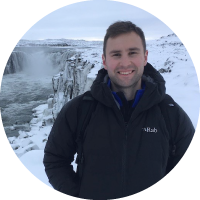
Chris Ayliffe is an Iceland-based travel and Northern Lights enthusiast as well as the Chief Marketing Officer for Traveo. Though originally from the UK, Chris now lives in Reykjavik and enjoys nothing more than to get out of the city, explore, and take lots of photographs. To rebel against the lyrics of TLC, Chris can always be found chasing waterfalls! Find him on Instagram as @frozenbritabroad.
Insider tips, inspiration and deals - delivered straight to your inbox.